Yunfan Liu
A Simple yet Effective DDG Predictor is An Unsupervised Antibody Optimizer and Explainer
Feb 10, 2025Abstract:The proteins that exist today have been optimized over billions of years of natural evolution, during which nature creates random mutations and selects them. The discovery of functionally promising mutations is challenged by the limited evolutionary accessible regions, i.e., only a small region on the fitness landscape is beneficial. There have been numerous priors used to constrain protein evolution to regions of landscapes with high-fitness variants, among which the change in binding free energy (DDG) of protein complexes upon mutations is one of the most commonly used priors. However, the huge mutation space poses two challenges: (1) how to improve the efficiency of DDG prediction for fast mutation screening; and (2) how to explain mutation preferences and efficiently explore accessible evolutionary regions. To address these challenges, we propose a lightweight DDG predictor (Light-DDG), which adopts a structure-aware Transformer as the backbone and enhances it by knowledge distilled from existing powerful but computationally heavy DDG predictors. Additionally, we augmented, annotated, and released a large-scale dataset containing millions of mutation data for pre-training Light-DDG. We find that such a simple yet effective Light-DDG can serve as a good unsupervised antibody optimizer and explainer. For the target antibody, we propose a novel Mutation Explainer to learn mutation preferences, which accounts for the marginal benefit of each mutation per residue. To further explore accessible evolutionary regions, we conduct preference-guided antibody optimization and evaluate antibody candidates quickly using Light-DDG to identify desirable mutations.
CC-Diff: Enhancing Contextual Coherence in Remote Sensing Image Synthesis
Dec 11, 2024Abstract:Accurately depicting real-world landscapes in remote sensing (RS) images requires precise alignment between objects and their environment. However, most existing synthesis methods for natural images prioritize foreground control, often reducing the background to plain textures. This neglects the interaction between foreground and background, which can lead to incoherence in RS scenarios. In this paper, we introduce CC-Diff, a Diffusion Model-based approach for RS image generation with enhanced Context Coherence. To capture spatial interdependence, we propose a sequential pipeline where background generation is conditioned on synthesized foreground instances. Distinct learnable queries are also employed to model both the complex background texture and its semantic relation to the foreground. Extensive experiments demonstrate that CC-Diff outperforms state-of-the-art methods in visual fidelity, semantic accuracy, and positional precision, excelling in both RS and natural image domains. CC-Diff also shows strong trainability, improving detection accuracy by 2.04 mAP on DOTA and 2.25 mAP on the COCO benchmark.
Revealing Key Details to See Differences: A Novel Prototypical Perspective for Skeleton-based Action Recognition
Nov 28, 2024Abstract:In skeleton-based action recognition, a key challenge is distinguishing between actions with similar trajectories of joints due to the lack of image-level details in skeletal representations. Recognizing that the differentiation of similar actions relies on subtle motion details in specific body parts, we direct our approach to focus on the fine-grained motion of local skeleton components. To this end, we introduce ProtoGCN, a Graph Convolutional Network (GCN)-based model that breaks down the dynamics of entire skeleton sequences into a combination of learnable prototypes representing core motion patterns of action units. By contrasting the reconstruction of prototypes, ProtoGCN can effectively identify and enhance the discriminative representation of similar actions. Without bells and whistles, ProtoGCN achieves state-of-the-art performance on multiple benchmark datasets, including NTU RGB+D, NTU RGB+D 120, Kinetics-Skeleton, and FineGYM, which demonstrates the effectiveness of the proposed method. The code is available at https://github.com/firework8/ProtoGCN.
Vision Calorimeter for Anti-neutron Reconstruction: A Baseline
Aug 20, 2024



Abstract:In high-energy physics, anti-neutrons ($\bar{n}$) are fundamental particles that frequently appear as final-state particles, and the reconstruction of their kinematic properties provides an important probe for understanding the governing principles. However, this confronts significant challenges instrumentally with the electromagnetic calorimeter (EMC), a typical experimental sensor but recovering the information of incident $\bar{n}$ insufficiently. In this study, we introduce Vision Calorimeter (ViC), a baseline method for anti-neutron reconstruction that leverages deep learning detectors to analyze the implicit relationships between EMC responses and incident $\bar{n}$ characteristics. Our motivation lies in that energy distributions of $\bar{n}$ samples deposited in the EMC cell arrays embody rich contextual information. Converted to 2-D images, such contextual energy distributions can be used to predict the status of $\bar{n}$ ($i.e.$, incident position and momentum) through a deep learning detector along with pseudo bounding boxes and a specified training objective. Experimental results demonstrate that ViC substantially outperforms the conventional reconstruction approach, reducing the prediction error of incident position by 42.81% (from 17.31$^{\circ}$ to 9.90$^{\circ}$). More importantly, this study for the first time realizes the measurement of incident $\bar{n}$ momentum, underscoring the potential of deep learning detectors for particle reconstruction. Code is available at https://github.com/yuhongtian17/ViC.
Teach Harder, Learn Poorer: Rethinking Hard Sample Distillation for GNN-to-MLP Knowledge Distillation
Jul 20, 2024



Abstract:To bridge the gaps between powerful Graph Neural Networks (GNNs) and lightweight Multi-Layer Perceptron (MLPs), GNN-to-MLP Knowledge Distillation (KD) proposes to distill knowledge from a well-trained teacher GNN into a student MLP. In this paper, we revisit the knowledge samples (nodes) in teacher GNNs from the perspective of hardness, and identify that hard sample distillation may be a major performance bottleneck of existing graph KD algorithms. The GNN-to-MLP KD involves two different types of hardness, one student-free knowledge hardness describing the inherent complexity of GNN knowledge, and the other student-dependent distillation hardness describing the difficulty of teacher-to-student distillation. However, most of the existing work focuses on only one of these aspects or regards them as one thing. This paper proposes a simple yet effective Hardness-aware GNN-to-MLP Distillation (HGMD) framework, which decouples the two hardnesses and estimates them using a non-parametric approach. Finally, two hardness-aware distillation schemes (i.e., HGMD-weight and HGMD-mixup) are further proposed to distill hardness-aware knowledge from teacher GNNs into the corresponding nodes of student MLPs. As non-parametric distillation, HGMD does not involve any additional learnable parameters beyond the student MLPs, but it still outperforms most of the state-of-the-art competitors. HGMD-mixup improves over the vanilla MLPs by 12.95% and outperforms its teacher GNNs by 2.48% averaged over seven real-world datasets.
Short-Long Convolutions Help Hardware-Efficient Linear Attention to Focus on Long Sequences
Jun 12, 2024



Abstract:To mitigate the computational complexity in the self-attention mechanism on long sequences, linear attention utilizes computation tricks to achieve linear complexity, while state space models (SSMs) popularize a favorable practice of using non-data-dependent memory pattern, i.e., emphasize the near and neglect the distant, to processing sequences. Recent studies have shown the priorities by combining them as one. However, the efficiency of linear attention remains only at the theoretical level in a causal setting, and SSMs require various designed constraints to operate effectively on specific data. Therefore, in order to unveil the true power of the hybrid design, the following two issues need to be addressed: (1) hardware-efficient implementation for linear attention and (2) stabilization of SSMs. To achieve this, we leverage the thought of tiling and hierarchy to propose CHELA (short-long Convolutions with Hardware-Efficient Linear Attention), which replaces SSMs with short-long convolutions and implements linear attention in a divide-and-conquer manner. This approach enjoys global abstraction and data-dependent selection from stable SSM and linear attention while maintaining real linear complexity. Our comprehensive experiments on the Long Range Arena benchmark and language modeling tasks demonstrate the effectiveness of the proposed method.
vHeat: Building Vision Models upon Heat Conduction
May 26, 2024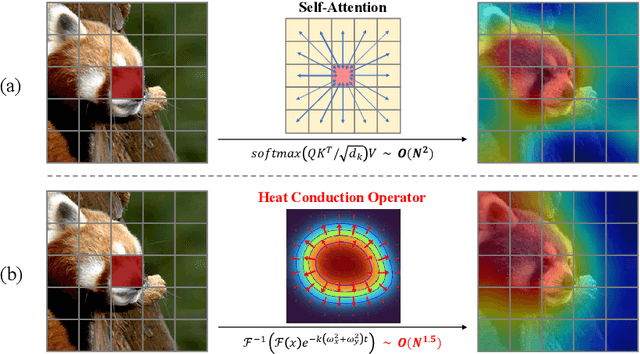

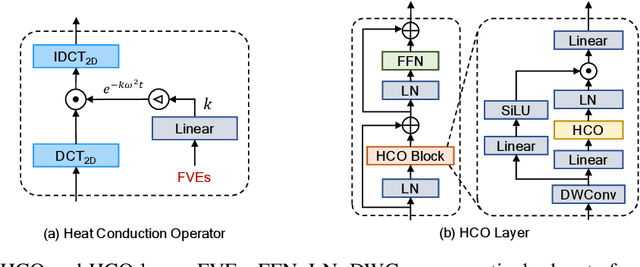

Abstract:A fundamental problem in learning robust and expressive visual representations lies in efficiently estimating the spatial relationships of visual semantics throughout the entire image. In this study, we propose vHeat, a novel vision backbone model that simultaneously achieves both high computational efficiency and global receptive field. The essential idea, inspired by the physical principle of heat conduction, is to conceptualize image patches as heat sources and model the calculation of their correlations as the diffusion of thermal energy. This mechanism is incorporated into deep models through the newly proposed module, the Heat Conduction Operator (HCO), which is physically plausible and can be efficiently implemented using DCT and IDCT operations with a complexity of $\mathcal{O}(N^{1.5})$. Extensive experiments demonstrate that vHeat surpasses Vision Transformers (ViTs) across various vision tasks, while also providing higher inference speeds, reduced FLOPs, and lower GPU memory usage for high-resolution images. The code will be released at https://github.com/MzeroMiko/vHeat.
VMamba: Visual State Space Model
Jan 18, 2024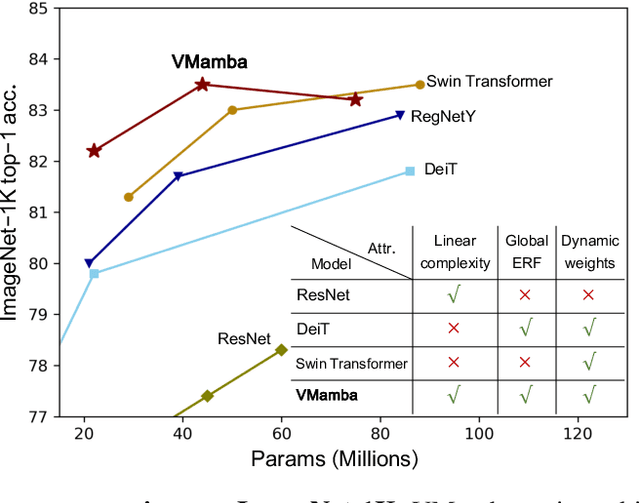
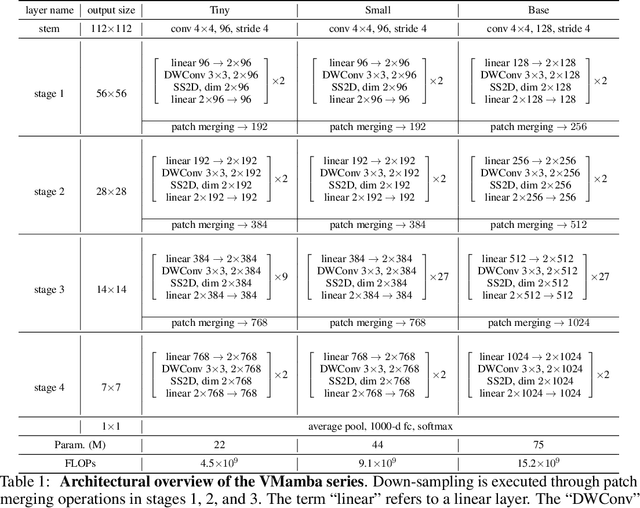
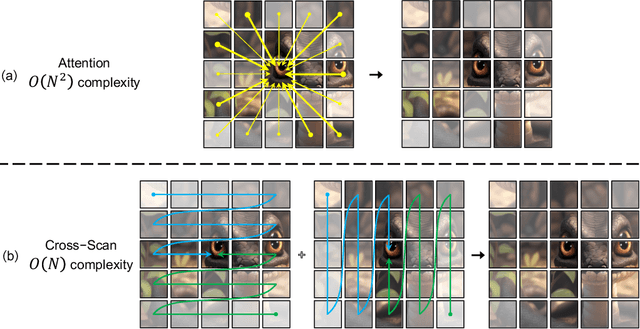
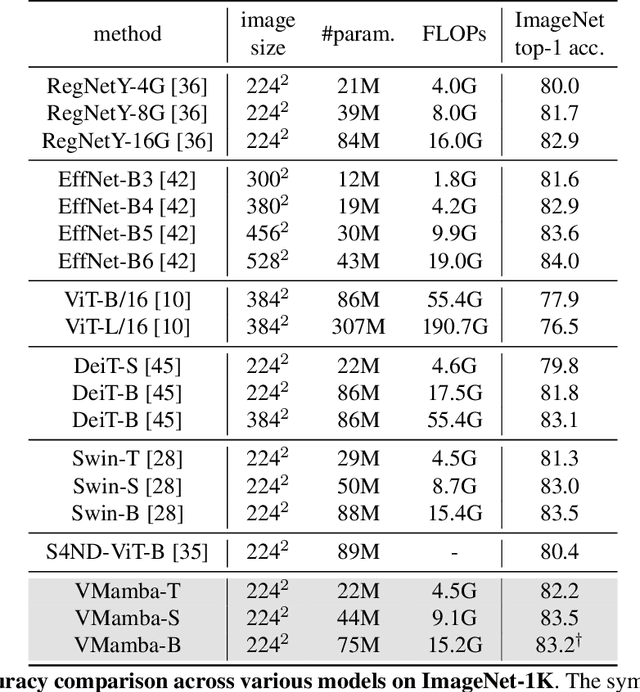
Abstract:Convolutional Neural Networks (CNNs) and Vision Transformers (ViTs) stand as the two most popular foundation models for visual representation learning. While CNNs exhibit remarkable scalability with linear complexity w.r.t. image resolution, ViTs surpass them in fitting capabilities despite contending with quadratic complexity. A closer inspection reveals that ViTs achieve superior visual modeling performance through the incorporation of global receptive fields and dynamic weights. This observation motivates us to propose a novel architecture that inherits these components while enhancing computational efficiency. To this end, we draw inspiration from the recently introduced state space model and propose the Visual State Space Model (VMamba), which achieves linear complexity without sacrificing global receptive fields. To address the encountered direction-sensitive issue, we introduce the Cross-Scan Module (CSM) to traverse the spatial domain and convert any non-causal visual image into order patch sequences. Extensive experimental results substantiate that VMamba not only demonstrates promising capabilities across various visual perception tasks, but also exhibits more pronounced advantages over established benchmarks as the image resolution increases. Source code has been available at https://github.com/MzeroMiko/VMamba.
Spatial Transform Decoupling for Oriented Object Detection
Aug 21, 2023



Abstract:Vision Transformers (ViTs) have achieved remarkable success in computer vision tasks. However, their potential in rotation-sensitive scenarios has not been fully explored, and this limitation may be inherently attributed to the lack of spatial invariance in the data-forwarding process. In this study, we present a novel approach, termed Spatial Transform Decoupling (STD), providing a simple-yet-effective solution for oriented object detection with ViTs. Built upon stacked ViT blocks, STD utilizes separate network branches to predict the position, size, and angle of bounding boxes, effectively harnessing the spatial transform potential of ViTs in a divide-and-conquer fashion. Moreover, by aggregating cascaded activation masks (CAMs) computed upon the regressed parameters, STD gradually enhances features within regions of interest (RoIs), which complements the self-attention mechanism. Without bells and whistles, STD achieves state-of-the-art performance on the benchmark datasets including DOTA-v1.0 (82.24% mAP) and HRSC2016 (98.55% mAP), which demonstrates the effectiveness of the proposed method. Source code is available at https://github.com/yuhongtian17/Spatial-Transform-Decoupling.
3D-Aware Adversarial Makeup Generation for Facial Privacy Protection
Jun 26, 2023



Abstract:The privacy and security of face data on social media are facing unprecedented challenges as it is vulnerable to unauthorized access and identification. A common practice for solving this problem is to modify the original data so that it could be protected from being recognized by malicious face recognition (FR) systems. However, such ``adversarial examples'' obtained by existing methods usually suffer from low transferability and poor image quality, which severely limits the application of these methods in real-world scenarios. In this paper, we propose a 3D-Aware Adversarial Makeup Generation GAN (3DAM-GAN). which aims to improve the quality and transferability of synthetic makeup for identity information concealing. Specifically, a UV-based generator consisting of a novel Makeup Adjustment Module (MAM) and Makeup Transfer Module (MTM) is designed to render realistic and robust makeup with the aid of symmetric characteristics of human faces. Moreover, a makeup attack mechanism with an ensemble training strategy is proposed to boost the transferability of black-box models. Extensive experiment results on several benchmark datasets demonstrate that 3DAM-GAN could effectively protect faces against various FR models, including both publicly available state-of-the-art models and commercial face verification APIs, such as Face++, Baidu and Aliyun.
 Add to Chrome
Add to Chrome Add to Firefox
Add to Firefox Add to Edge
Add to Edge